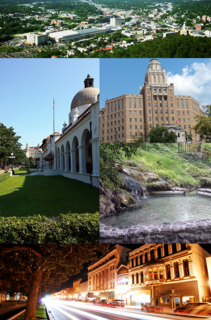
This is a list of properties and historic districts in Arkansas that are listed on the National Register of Historic Places. There are more than 2,600 listings in the state, including at least 8 listings in each of Arkansas's 75 counties.

The Stitt House is an Italianate style house located in Hot Springs, Arkansas. It is listed on the National Register of Historic Places.
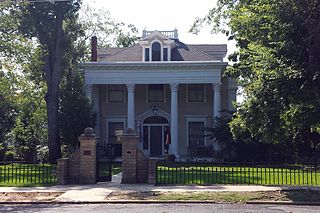
The William H. Martin House is a historic house at 815 Quapaw Avenue in Hot Springs, Arkansas. It was designed by architect Frank W. Gibb in 1904 and built in the same year. It includes Colonial Revival and Classical Revival architectural elements. It is an imposing building with a two-story Greek temple portico supported by four fluted Corinthian style pillars. The portico's cornice is modillioned with scrolled brackets, and has a band of dentil molding. When built, the house was on the outskirts of Hot Springs.

Couchwood is the summer estate of Harvey C. Couch, an industrialist and founder of Arkansas Light and Power in the early 20th century. The estate, located at 601 Couchwood Road, is southeast of Hot Springs, Arkansas, straddling the border of Garland and Hot Spring counties on the north shore of Lake Catherine.
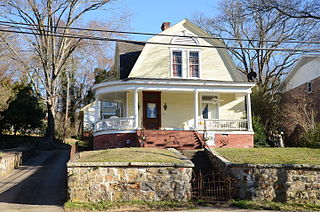
The Fordyce House is a historic house at 746 Park Avenue in Hot Springs, Arkansas. It is a 1-1/2 story wood frame structure, with a hip roof that has large cross-gabled gambrel dormers projecting in each direction. It has a curved wraparound porch supported by Tuscan columns. It was built in 1910 to a design by architect Charles L. Thompson, and is an excellent local example of Colonial Revival architecture.

John Parks Almand was an American architect who practiced in Arkansas from 1912 to 1962. Among other works, he designed the Art Deco Hot Springs Medical Arts Building, which was the tallest building in Arkansas from 1930 to 1958. Several of his works, including the Medical Arts Building and Little Rock Central High School, are listed on the National Register of Historic Places.
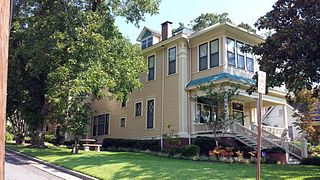
The Walter Beauchamp House is a historic house at 492 Prospect Avenue in Hot Springs, Arkansas. Built in 1905, it is a "double decker" single-family house, unusual both for its setting on a spacious lot, and for the style, which is generally uncommon in Hot Springs. Houses of this type are typically found on narrow lots in densely-built urban areas and have two units; this one is set on a larger lot similar to others in the neighborhood and has a single large unit. Walter Beauchamp, the builder, was a conductor on the Chicago, Rock Island and Pacific Railroad.
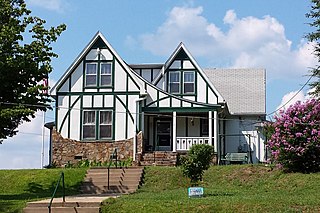
The Bill Clinton Boyhood Home, also known as the Birnbaum-Shubetz House, is a historic house at 1011 Park Avenue in Hot Springs, Arkansas. Built about 1896 and redesigned in the Tudor Revival in 1938, it was the home of United States President Bill Clinton between 1954 and 1961, teenage years in which he first determined to enter politics. In addition to this national historic significance, it is locally notable as a fine example of Tudor Revival architecture. The house is a private residence and is not open to the public.
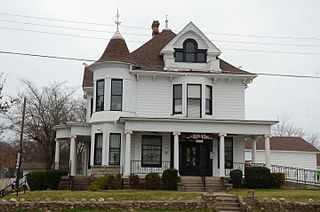
The Martone House is a historic house at 705 Malvern Avenue in Hot Springs, Arkansas. It is a 2-1/2 story wood frame structure, with a hip roof, clapboard siding, and a stone foundation. It has Queen Anne Victorian styling, with a gabled projecting window bay, rounded turret projecting at one corner, and a wraparound porch. It was built in 1907 for Thomas and Nina (Cascoldt) Doherty, and is notable as one of Hot Springs' first motel properties, as it was where the Dohertys not only let rooms in the house, but also built cabins to the rear of the property to house more visitors.

The Fordyce–Ricks House Historic District encompasses a locally rare collection of Adirondack Architecture structures located at 1501 Park Avenue in Hot Springs, Arkansas. The district encompasses 37 acres (15 ha) of land that originally belonged to Samuel W. Fordyce, a prominent railroad executive who had a major role in promoting and developing Hot Springs as a resort community. The district includes a 1-1/2 story octagonal log house, three outbuildings, and a landscaped rustic environment. 20 acres (8.1 ha) of the former estate are now a part of Hot Springs National Park.

The King-Neimeyer-Mathis House is a historic house at 2145 Malvern Road in Hot Springs, Arkansas, opposite the Hot Springs Golf Club. It is a 1-1/2 story Craftsman style house, with a broad shallow-pitch gable roof. Originally built outside the city, the city's growth has brought it within the city limits, but it still stands on more than 7 acres (2.8 ha), along with a number of agricultural outbuildings. The house was built in 1917-18 by D. D. King as a summer house, apparently due in part to its proximity to the golf club.

The Passmore House is a historic house at 846 Park Avenue in Hot Springs, Arkansas. It is a large 1-1/2 story wood frame structure, with a seven-bay facade topped by a mansard roof with a crested surround and elaborately styled dormers. A central two-story pavilion projects, with a double-door entrance on the first floor, and French doors on the second level that open to a shallow lattice balcony. The house was built in 1873 for Dr. Pauldin Passmore, one of Hot Springs's first doctors, who benefitted from the locality's popularity as a site for the treatment of medical conditions.

The Hot Springs Railroad Roundhouse is a historic railroad roundhouse at 132 Front Street in Malvern, Arkansas. Built in 1887, it is the last known surviving substantially intact roundhouse in the state. It has brick walls and a granite foundation, and houses five stalls. It was built by the Hot Springs Railroad as a service facility for its locomotives, and was used in that capacity until 1904. It has since seen use as a warehouse and manufacturing facility.

The Charles N. Rix House is a historic house at 628 Quapaw Avenue in Hot Springs, Arkansas. It is a two-story American Foursquare wood frame structure, with a hip roof and a brick foundation. It has a single-story porch extending across its front, supported by Ionic columns and a turned-spindle balustrade. The roof is adorned with projecting dormers. The house was probably built about 1907, by Charles N. Rix, a banker who moved to Hot Springs in 1879, and was a leading force in the development of the city as a resort center.
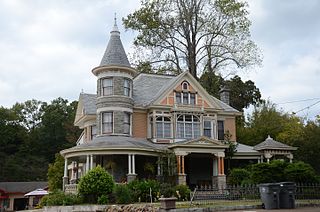
The Short-Dodson House is a historic house at 755 Park Avenue in Hot Springs, Arkansas. It is a 2-1/2 story masonry structure, its exterior finished in a combination of stone, brick, and wood. It has asymmetrical massing with projecting gables of varying sizes and shapes, and a round corner turret, with an undulating single-story porch wrapping around its south side. It was designed by Joseph G. Horn, and built c. 1902 for Dr. Omar Short, one of many doctors whose homes lined Park Avenue.

The Whittington Park Historic District encompasses a mainly residential area in northwestern Hot Springs, Arkansas. The district is centered on Whittington Park, a landscaped design of Frederick Law Olmsted built in the 1890s by the National Park Service. The park is lined to the north and south by a neighborhood built out in two phases, 1920–40 and 1950-1960s. These building periods are represented by a significant number of modest Craftsman and Ranch-style houses, built primarily for people of modest means. There are also several Queen Anne Victorians in the area, the most notable of which stands at 524 Whittington.
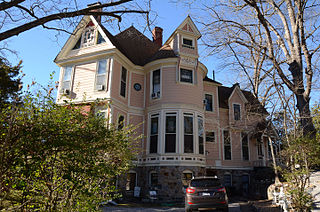
Wildwood is a historic house at 808 Park Avenue in Hot Springs, Arkansas. It is a somewhat rambling 2-1/2 story wood frame structure, with a variety of projecting sections, gables, and porches typical of the late Victorian Queen Anne period. Notable features include a round corner turret, steeply pitched roofs, and a variety of exterior sheathing. The interior is as ornate and elaborate as the exterior, with well-preserved woodwork from different types of hardwood in each downstairs room. The house was designed by Phillip Van Patten and built in 1884 for his brother-in-law, Dr. Harvey Prosper Ellsworth. The house is now a bed and breakfast inn.

The Hot Springs Federal Courthouse is located at 100 Reserve Street in Hot Springs, Arkansas. It is a three-story building, with a steel frame clad in orange brick, with porcelain panels and aluminum-clad windows. It was designed by the Little Rock firm Wittenberg, Delony & Davidson, and was built in 1959-60 on the site of the Eastman Hotel, once one of the city's largest spa hotels. It is one of the city's best examples of commercial International architecture.

